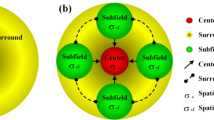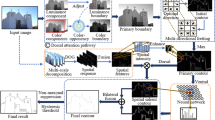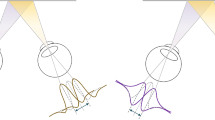Abstract
Salient contour detection is the key step of visual perception and is very important for visual detection and object recognition. In this paper, a new contour detection method, which is based on the bilateral asymmetric receptive field mechanism of the visual pathway, is proposed. First, the classical receptive field of primary visual cortex neurons was simulated, and the 2D Gaussian derivative was used to detect the primary contour response of the input image. Then, the asymmetric receptive field structure was introduced to enhance the contrast difference in local regions. Assuming that unilateral asymmetric receptive fields will suppress the intensity imbalance of the primary contour in the image, the strategy of weight information fusion, which is based on the bilateral asymmetric receptive field multi-scale inhibition, was proposed. Finally, texture suppression was performed with varying intensity in the local regions of the primary contour in the image, and the salient contour was detected. The salient contour detection method, which is based on bilateral asymmetric receptive fields proposed in this study, provides new ideas for the subsequent image understanding and analysis that are on the basis of the visual mechanism.









Similar content being viewed by others
References
Papari, G., Petkov, N.: Edge and line oriented contour detection: state of the art. Image Vis. Comput. 29(2), 79–103 (2011)
Hansen, T., Gegenfurtner, K.R.: Color contributes to object-contour perception in natural scenes. J. Vis. 17(3), 14 (2017)
Gupta, D., Anand, R.S.: A hybrid edge-based segmentation approach for ultrasound medical images. Biomed. Signal Process. Contr. 31, 116–126 (2017)
Zhang, P., Zhuo, T., Huang, H., Kankanhalli, M.: Saliency flow based video segmentation via motion guided contour refinement. Signal Process. 142, 431–440 (2018)
Li, Y., Wang, Y., Li, S.: Recurrent processing of contour integration in the human visual cortex as revealed by fMRI-guided TMS. Cereb. Cortex 29(1), 17–26 (2017)
Kang, X., Kong, Q., Zeng, Y., Xu, B.: A fast contour detection model inspired by biological mechanisms in primary vision system. Font. Comput. Neurosci. 12, 28–28 (2018)
Fu, Y., Zeng, H., Ma, L., Ni, Z., Zhu, J., Ma, K.K.: Screen content image quality assessment using multi-scale difference of gaussian. IEEE Trans. Circ. Syst. Vid. Technol. 28(9), 2428–2432 (2018)
Moallem, P., Tahvilian, H., Monadjemi, S.A.: Parametric active contour model using gabor balloon energy for texture segmentation. Signal Image Vid. Process. 10(2), 1–8 (2015)
Wang, J., Kobayashi, E., Sakuma, I.: Coarse-to-fine dot array marker detection with accurate edge localization for stereo visual tracking. Biomed. Signal Process. Contr. 15, 49–59 (2015)
Grigorescu, C., Petkov, N., Westenberg, M.A.: Contour detection based on nonclassical receptive field inhibition. IEEE Trans. Image Process. 12(7), 729–739 (2003)
Azzopardi, G., Petkov, N.: A corf computational model of a simple cell that relies on lgn input outperforms the gabor function model. Biol. Cybern. 106(3), 177–189 (2012)
Papari, G., Petkov, N.: An improved model for surround suppression by steerable filters and multilevel inhibition with application to contour detection. Pattern Recogn. 44(9), 1999–2007 (2011)
Tang, Q., Sang, N., Zhang, T.: Contour detection based on contextual influences. Image Vis. Comput. 25(8), 1282–1290 (2007)
Zeng, C., Li, Y., Li, C.: Center–surround interaction with adaptive inhibition: a computational model for contour detection. NeuroImage 55(1), 49–66 (2011)
Li, Z.: A neural model of contour integration in the primary visual cortex. Neural Comput. 10(4), 903–940 (1998)
Yang, K.F., Li, C.Y., Li, Y.J.: Multifeature-based surround inhibition improves contour detection in natural images. IEEE Trans. Image Process. 23(12), 5020–5032 (2014)
Zhao, R., Wu, M., Liu, X., Zou, B., Li, F.: Orientation histogram-based center-surround interaction: an integration approach for contour detection. Neural Comput. 29(1), 171–193 (2017)
Cao, Y.J., Lin, C., Pan, Y.J., Zhao, H.J.: Application of the center–surround mechanism to contour detection. Multimed. Tools Appl. 2019, 1–21 (2019)
Lin, C., Qing, Z., Cao, Y.J.: Multi-scale contour detection model based on fixational eye movement mechanism. Signal Image Vid. Process. 14, 1–9 (2019)
Hoshino, N., Matsumoto, N.: Intracellular analysis of directional sensitivity of tectal neurons of the frog. Brain Res. 966(2), 185–193 (2003)
Mante, V., Frazor, R.A., Bonin, V., Geisler, W.S., Carandini, M.: Independence of luminance and contrast in natural scenes and in the early visual system. Nat. Neurosci. 8(12), 1690–1690 (2005)
Frazor, R.A., Geisler, W.S.: Local luminance and contrast in natural images. Vis. Res. 46(10), 1585–1598 (2006)
Lindgren, J.T., Hurri, J., Hyvärinen, A.: Spatial dependencies between local luminance and contrast in natural images. J. Vis. 8(12), 6–6 (2008)
Arbelaez, P., Maire, M., Fowlkes, C., Malik, J.: Contour detection and hierarchical image segmentation. IEEE Trans. Pattern Anal. Mach. Intell. 33(5), 898–916 (2011)
Liu, Y., Cheng, M.M., Hu, X., Wang, K., Bai, X.: Richer convolutional features for edge detection. In: Proceedings of the IEEE Conference on Computer Vision and Pattern Recognition Abbreviation, pp. 3000–3009 (2017)
Maninis, K.K., Tuset, J.P., Arbeláez, P., Gool, L.V.: Convolutional oriented boundaries. In: European Conference on Computer Vision, pp. 580–596 (2016)
Xie, S., Tu, Z.: Holistically-nested edge detection. In: Proceedings of IEEE International Conference on Computer Vision, pp. 1395–1403 (2015)
Arbelaez, P., Tuset, J.P., Barron, J.P., Marques, F., Malik, J.: Multiscale combinatorial grouping. In: Proceedings of IEEE Conference on Computer Vision Pattern Recognition, pp. 328–335 (2014)
Martin, D.R., Fowlkes, C.C., Malik, J.: Learning to detect natural image boundaries using local brightness, color, and texture cues. IEEE Trans. Pattern Anal. Mach. Intell. 26(5), 530–549 (2004)
Piotr, D., Tu, Z., Belongie, S.: Supervised learning of edges and object boundaries. In: Proceedings of IEEE Conference on Computer Vision Pattern Recognition, vol. 2, pp. 1964–1971 (2006)
Canny, J.F.: A computation approach to edge detection. IEEE Trans. Pattern Anal. Mach. Intell. 8(6), 670–700 (1986)
Spratling, S., Michael, W.: Image segmentation using a sparse coding model of cortical area V1. IEEE Trans. Image Process. 22(4), 1631–1643 (2013)
Acknowledgements
The work was supported in part by the National Natural Science Foundation of China (61501154).
Author information
Authors and Affiliations
Corresponding author
Additional information
Publisher's Note
Springer Nature remains neutral with regard to jurisdictional claims in published maps and institutional affiliations.
Rights and permissions
About this article
Cite this article
Fang, T., Fan, Y. & Wu, W. Salient contour detection on the basis of the mechanism of bilateral asymmetric receptive fields. SIViP 14, 1461–1469 (2020). https://doi.org/10.1007/s11760-020-01689-1
Received:
Revised:
Accepted:
Published:
Issue Date:
DOI: https://doi.org/10.1007/s11760-020-01689-1




